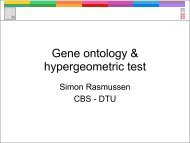Computational tools and Interoperability in Comparative ... - CBS
Computational tools and Interoperability in Comparative ... - CBS
Computational tools and Interoperability in Comparative ... - CBS
You also want an ePaper? Increase the reach of your titles
YUMPU automatically turns print PDFs into web optimized ePapers that Google loves.
Orig<strong>in</strong>s of V. cholerae<br />
Table 2 (cont<strong>in</strong>ued)<br />
1942032–1941658 Middle operon regulator-related<br />
1944457–1943306 eha prote<strong>in</strong><br />
Gap G (chromosome II, 21300–223000)<br />
213207–214250 GMP reductase<br />
214574–215725 DNA methyltransferase<br />
220262–219825 IS1004 transposase<br />
All gene annotations are taken from the reference genome V. cholerae<br />
stra<strong>in</strong> N16961. Hypothetical prote<strong>in</strong>s were excluded. Gaps A, E <strong>and</strong> G<br />
are conserved <strong>in</strong> pathogenic stra<strong>in</strong>s, whereas gaps B, C, D <strong>and</strong> F are<br />
conserved <strong>in</strong> all V. cholerae genomes analysed (Figure 1)<br />
complete absence of homologues <strong>in</strong> the other Vibrio genomes<br />
strongly po<strong>in</strong>t towards a potential biological significance.<br />
Discussion<br />
The recent availability of many Vibrionaceae genomes,<br />
<strong>in</strong>clud<strong>in</strong>g a substantial number of V. cholerae genomes,<br />
allows the possibility to take a closer look at the similarities<br />
<strong>and</strong> differences of species with<strong>in</strong> the genus Vibrio. This can<br />
exam<strong>in</strong>e, on a genome scale, what dist<strong>in</strong>guishes V. cholerae<br />
from the other Vibrio species. S<strong>in</strong>ce not all V. cholerae<br />
isolates are pathogenic, the presence of the prophagebear<strong>in</strong>g<br />
cholera enterotox<strong>in</strong>, the ma<strong>in</strong> virulence factor for<br />
cholera, is not a suitable marker for this species. We<br />
attempted to identify a set of V. cholerae-specific genes,<br />
<strong>and</strong> also explored the <strong>in</strong>ternal diversity with<strong>in</strong> the V.<br />
cholerae genomes that have been sequenced to date.<br />
On a phylogenetic tree based on the 16S ribosomal RNA<br />
gene, those isolates that do not belong to the genus Vibrio<br />
were positioned as outliers, as expected. This tree further<br />
<strong>in</strong>dicated the closest resembl<strong>in</strong>g 16S rRNA sequence for<br />
the two sequenced Vibrio stra<strong>in</strong>s that are currently not<br />
assigned to a species. It was observed that the two<br />
sequenced V. parahaemolyticus stra<strong>in</strong>s were not placed<br />
together. The complete gene content of each genome was<br />
next compared by BLAST <strong>and</strong> the results were pooled <strong>in</strong>to<br />
gene families which were subjected to cluster analysis. This<br />
provided evidence that the 18 V. cholerae genomes fall <strong>in</strong>to<br />
two subclusters, one ma<strong>in</strong>ly conta<strong>in</strong><strong>in</strong>g cl<strong>in</strong>ical isolates <strong>and</strong><br />
the other environmental isolates.<br />
The gene family cluster<strong>in</strong>g, subsequent pan-genome<br />
analysis <strong>and</strong> the pairwise BLAST results, as summarised<br />
<strong>in</strong> the BLAST matrix, all supported the relatedness of<br />
Vibrio species Ex25 to V. parahaemolyticus 2210633 but<br />
not to V. parahaemolyticus 16. This latter genome was quite<br />
different from V. parahaemolyticus 2210633 <strong>in</strong> all analyses.<br />
Although it is possible that the species V. parahaemolyticus<br />
is far more genetically diverse than V. cholerae, A. fischeri<br />
or V. vulnificus, an alternative explanation is that one of the<br />
sequenced isolates is perhaps <strong>in</strong>correctly named as V.<br />
parahaemolyticus. The similarity between Vibrio species<br />
MED222 <strong>and</strong> V. splendidus based on gene families is <strong>in</strong><br />
agreement with their related 16S rRNA genes <strong>and</strong> published<br />
data [21]. However, <strong>in</strong> contrast to what the ribosomal<br />
gene suggests, our whole-genome comparison <strong>in</strong>dicates that<br />
the three Aliivibrio genomes (A. salmonicida <strong>and</strong> two A.<br />
fischeri) are not so different from Vibrio after all. Their<br />
recent placement <strong>in</strong> the genus Aliivibrio, a decision based<br />
on five genes (the 16S rRNA gene <strong>and</strong> four housekeep<strong>in</strong>g<br />
genes) <strong>and</strong> phenotypical characteristics [47], appears not to<br />
be reflective of the whole genome picture presented here.<br />
The BLAST results were graphically summarised <strong>in</strong> a<br />
BLAST atlas, which visualised V. cholerae-specific gene<br />
clusters. These coded for polysaccharide biosynthesis<br />
enzymes, response regulators <strong>and</strong> chemotaxis prote<strong>in</strong>s,<br />
amongst others. In addition, a V. cholerae-specific, histid<strong>in</strong>e<br />
k<strong>in</strong>ase two-component signal transduction regulatory system<br />
was identified. The two-component signal transduction<br />
pathway is a powerful regulat<strong>in</strong>g system for bacteria to<br />
adapt to a particular ecological niche. There is a precedent<br />
for this claim, as the <strong>in</strong>troduction of a s<strong>in</strong>gle regulatory<br />
prote<strong>in</strong> <strong>in</strong> Vibrio fischeri stra<strong>in</strong> MJ11 has been shown to<br />
specifically enable colonization of the squid Euprymna<br />
scolopes [26].<br />
As expected, the ma<strong>in</strong> differences observed between V.<br />
cholerae cl<strong>in</strong>ical isolates <strong>and</strong> the environmental stra<strong>in</strong>s are<br />
due to genes related to virulence. Two exceptions are the<br />
presence of a number of virulence genes <strong>in</strong> the environmental<br />
stra<strong>in</strong> V. cholerae 2740-80 <strong>and</strong> the absence of<br />
enterotox<strong>in</strong> genes <strong>in</strong> cl<strong>in</strong>ical isolate M66-2. It has already<br />
been suggested that M66-2 might be a predecessor of<br />
p<strong>and</strong>emic, enterotoxic V. cholerae [11]. From sequence<br />
comparison of four housekeep<strong>in</strong>g genes, it was concluded<br />
that V. cholerae 2740-80 is <strong>in</strong>termediary between toxigenic<br />
<strong>and</strong> non-toxigenic isolates [30]. This view is confirmed by<br />
the data presented here, although we propose to consider<br />
the possibility that the isolate arose from a p<strong>and</strong>emic clone<br />
that has lost the CTXΦ prophage, rather than be<strong>in</strong>g a<br />
precursor of a pathogen.<br />
In conclusion, several different methods of genome<br />
comparisons have yielded a picture of V. cholerae genomes<br />
as form<strong>in</strong>g a dist<strong>in</strong>ct cluster, compared to related species,<br />
<strong>and</strong> a relatively small number of genes might be responsible<br />
for environmental niche adaptation <strong>and</strong> hence for generation<br />
of this dist<strong>in</strong>ct species. Likely c<strong>and</strong>idates <strong>in</strong>clude<br />
multiple two-component signal transduction regulatory<br />
prote<strong>in</strong>s as well as chemotaxis prote<strong>in</strong>s.<br />
Acknowledgements We would like to thank Tim B<strong>in</strong>newies for<br />
early work on this project, <strong>and</strong> also to the Danish Research Councils<br />
<strong>and</strong> the DTU Globalization funds for f<strong>in</strong>ancial support.









